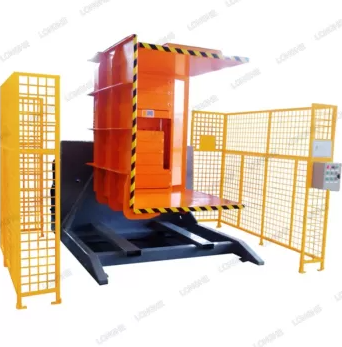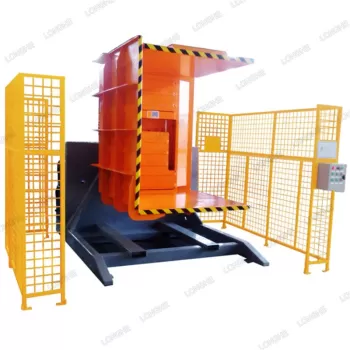A pallet inverter is a specialized machine designed to facilitate the rotation of pallet loads. It provides a safe and efficient method for reorienting or exchanging pallets without the need for manual labor or extensive handling. Pallet inverters are commonly used in industries such as manufacturing, warehousing, distribution, and retail, where the ability to quickly and accurately rotate loads is essential.
How Does a Pallet Inverter Work?
A pallet inverter typically consists of a sturdy frame structure with clamping arms or plates. The machine operates by securely gripping the load and then rotating it to the desired position. This process allows for the exchange of damaged or incorrect pallets, the removal of bottom boards, or the repositioning of loads for better accessibility or storage. Pallet inverters are available in various configurations, including manual, semi-automatic, and fully automated models, catering to different operational needs.


Benefits of Pallet Inverters
1. Improved Efficiency
Pallet inverters play a crucial role in streamlining material handling processes, leading to improved operational efficiency. By automating load rotation, pallet inverters eliminate the time-consuming and labor-intensive tasks associated with manual handling. They enable swift and precise repositioning of loads, reducing downtime and enhancing overall productivity.
2. Enhanced Product Safety
Ensuring the safety of products during handling and transportation is paramount. Pallet inverters provide a controlled environment for load rotation, minimizing the risk of damage or accidents. By securely clamping the load, the machine prevents shifting or slippage, ensuring that products remain intact and stable throughout the rotation process. This feature is particularly beneficial for delicate or fragile items that require extra care.
3. Versatility and Flexibility
Pallet inverters offer versatility and adaptability to handle a wide range of load types and sizes. They can accommodate loads with varying dimensions, weights, and packaging configurations. Whether you need to rotate pallets of bulk goods, boxed items, or irregularly shaped loads, a pallet inverter can efficiently handle the task. This versatility makes pallet inverters indispensable in industries with diverse product requirements.
4. Cost Savings
Implementing pallet inverters can lead to significant cost savings in the long run. By eliminating the need for manual labor and reducing the risk of product damage, businesses can minimize operational expenses and avoid costly rework or replacement. Moreover, the ability to exchange pallets and remove bottom boards can optimize storage space utilization, reducing the need for additional warehouse facilities or expanding existing ones.
Choosing the Right Pallet Inverter
Selecting the appropriate pallet inverter for your specific needs is crucial to maximize its benefits. Consider the following factors when choosing a pallet inverter:
Load Capacity: Ensure that the pallet inverter's load capacity aligns with your heaviest loads to maintain safety and efficiency.
Automation Level: Evaluate your operational requirements and consider whether a manual, semi-automatic, or fully automated pallet inverter suits your needs.
Compatibility: Verify that the pallet inverter is compatible with the pallet sizes, configurations, and materials commonly used in your industry.
Safety Features: Look for pallet inverters equipped with safety features such as load clamping mechanisms, emergency stop buttons, and safety interlocks to prioritize the well-being of your operators and products.
Conclusion
Pallet inverters offer a reliable and efficient solution for load rotation in material handling operations. By automating the process and ensuring product safety, they contribute to improved efficiency, reduced labor costs, and enhanced overall productivity. When selecting a pallet inverter, consider factors such as load capacity, automation level, compatibility, and safety features. Embracing the benefits of a pallet inverter can streamline your material handling processes and drive your business towards greater success.



Comments
Please Join Us to post.
0